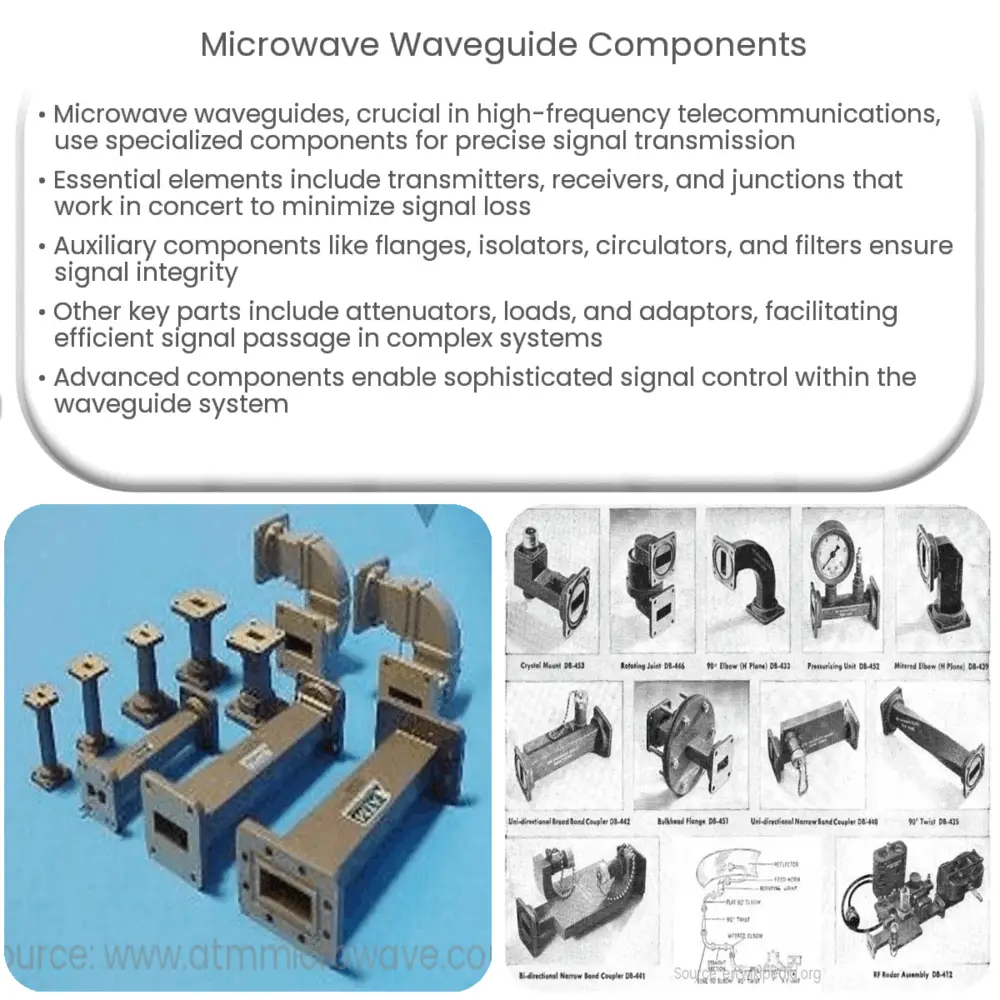Explore the fundamentals of microwave waveguide components, their roles in telecommunications, and the intricacies of their operation.

Microwave Waveguide Components
In the realm of telecommunications, particularly in the microwave spectrum, waveguides play a crucial role. Waveguides are special tubes through which electromagnetic waves are directed. Unlike traditional transmission lines that can handle waves at any frequency, waveguides are specifically designed for higher frequencies. The types of waves transmitted can be controlled by the physical parameters of the waveguide, offering the possibility for precise microwave telecommunications.
The Fundamentals
Understanding the components of microwave waveguides starts with appreciating their basic structure. A standard waveguide is essentially a hollow metallic tube. The size of the tube is determined by the wavelength of the microwave signals it is meant to transmit, making it larger than a typical transmission line. The dominant mode in rectangular waveguides is TE10 and the cut-off frequency is the lowest frequency that can propagate. Higher frequencies than this cut-off frequency can also propagate.
Primary Components
Let’s explore the essential elements of microwave waveguides:
- Waveguide Transmitter: This is where the electromagnetic waves enter the waveguide. The transmitter converts the input signal into a suitable form for propagation within the waveguide. This might involve amplification, frequency modulation, or other processes.
- Waveguide Receiver: Positioned at the other end of the waveguide, the receiver captures the waves and converts them back into a format that can be processed by conventional electronics. This could involve demodulation, down-conversion, or other methods of signal processing.
- Waveguide Junctions: These are points where the waveguide branches out or combines, allowing signals to be directed to different destinations or signals from different sources to be combined. Junctions can be of several types, including E-plane, H-plane, and Magic T junctions.
These components work in harmony to carry signals over long distances with minimal loss and distortion, hence enabling effective microwave communication.
Additional Components
Beyond the primary components, there are several others that are often found in practical waveguide systems:
- Waveguide Flanges: These are used to connect different waveguide sections together or to connect waveguides to other equipment. There are several standards for waveguide flanges, each with their specific design and performance characteristics.
- Waveguide Isolators and Circulators: These are devices that allow signals to pass in one direction but block them in the other, hence providing a way to manage signal flow and prevent reflections and interference.
- Waveguide Filters: These are used to reject or pass certain frequencies, thus helping to manage the signals that are sent through the waveguide.
These auxiliary elements are vital for the overall functioning of the waveguide, ensuring the integrity and fidelity of the signals that they carry.
Attenuators and Loads
Another significant component found in microwave waveguides is the attenuator. The purpose of an attenuator is to reduce the power level of a signal without appreciably distorting the waveform. These can be variable or fixed and are often required to protect other components from potentially damaging signal levels.
Further, waveguide loads, also known as terminations or dumps, are designed to absorb electromagnetic energy without reflecting it back into the waveguide. It’s imperative to have well-designed loads to prevent standing waves and the potential for damage to the waveguide or connected components.
Waveguide Adaptors and Transitions
Waveguide adaptors and transitions are used to connect waveguides of different shapes and sizes, or waveguides to coaxial lines. Adaptors can be of several types, including twists, bends, tapers, and flexible sections. They are crucial for the integration of waveguides into more complex systems, ensuring that signals can be passed efficiently from one part of a system to another.
Advanced Components
In addition to the basic components, there are more advanced components used in complex waveguide systems. These include waveguide switches, phase shifters, directional couplers, power dividers, and even waveguide-based oscillators and amplifiers. Each of these components offers additional functionality, enabling sophisticated signal processing and control within the waveguide system.
Conclusion
In conclusion, microwave waveguide components play an essential role in the transmission and manipulation of high-frequency signals, most notably in microwave telecommunications. Understanding these components, their functions, and their interplay is pivotal to the efficient design and operation of these systems. From transmitters and receivers to filters, attenuators, and advanced components like phase shifters and directional couplers, each contributes to the efficiency and fidelity of microwave signal transmission. As we progress further into the age of high-frequency communications, the significance of these waveguide components will only continue to grow.

